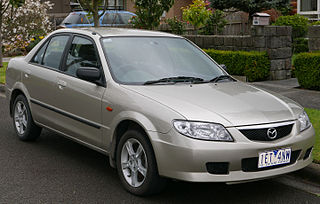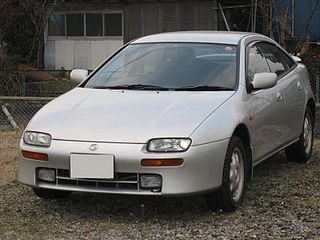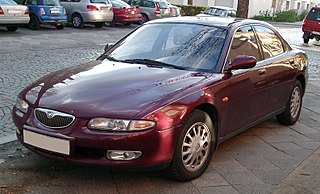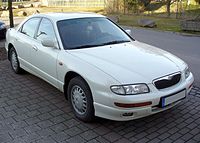
Mazda Motor Corporation, also known as simply Mazda, is a Japanese multinational automotive manufacturer headquartered in Fuchū, Hiroshima, Japan. The company was founded on January 30, 1920, as Toyo Cork Kogyo Co., Ltd., a cork-making factory, by Jujiro Matsuda. It changed its name to Toyo Kogyo Co., Ltd. in 1927 and started producing vehicles in 1931. The name Mazda was derived from Ahura Mazda, the god of harmony, intelligence and wisdom in Zoroastrianism, as well as from the surname of the founder. Mazda is one of the largest automakers in Japan and the world. In 2015, it produced 1.5 million vehicles for global sales, of which nearly one million were made in Japan and the rest in various other countries. It ranked as the 15th-largest automaker by production volume globally in 2015. Mazda is known for its innovative technologies, such as the Wankel engine, the SkyActiv platform, and the Kodo Design language. It also has a long history of motorsport involvement, winning the 24 Hours of Le Mans in 1991 with the rotary-powered Mazda 787B. Mazda has several alliances and partnerships with other automakers, such as Toyota, Nissan, Isuzu, Suzuki and Ford.

The Mazda MX-3 is a four-seat, front wheel drive coupé manufactured and marketed by Mazda, introduced at the Geneva Auto Show in March 1991 and marketed for model years 1992–1998.

The Honda Inspire is a mid-size sedan derived from the Honda Accord chassis. The first Inspire debuted in late 1989 as the Accord Inspire, a sister nameplate to the Honda Vigor. It was sold at different retail channels in Japan, known as Honda Verno for the Vigor/Saber, and as the Inspire at Honda Clio stores.

The Mazda Capella, also known as the 626 in Europe, North America and Southeast Asia, is a mid-size car that was manufactured by Mazda from 1970 until 2002. Sold in the Japanese domestic market under the Capella name, the vehicle was also commonly known in other major markets as the Mazda 626. Ford, Mazda's partner at the time, also used the Capella platform to create the Ford Telstar and Ford Probe. 4,345,279 of the 626 and Telstar models were sold worldwide.

The Mazda Luce is an executive car that was produced by Mazda in Japan from 1966 until 1991. It was widely exported as the Mazda 929 from 1973 to 1991 as Mazda's largest sedan. Later generations were installed with luxury items and interiors as the Luce became the flagship offering. The Luce was replaced by the Sentia in 1991 which was also exported under the 929 nameplate.

The Mazda MX-6 is a front-engine, front-wheel-drive coupé manufactured and marketed by Mazda from 1987 to 1997 across two generations.

The Mazda Familia, also marketed prominently as the Mazda 323, Mazda Protegé and Mazda Allegro, is a small family car that was manufactured by Mazda between 1963 and 2003. The Familia line was replaced by the Mazda3/Axela for 2004.

The Mazda K-series automobile engine is a short stroke 60° 24-valve V6 with belt-driven DOHC and all-aluminium construction. Displacements range from 1.8 L to 2.5 L. They all use a 27-degree DOHC valvetrain with directly actuated hydraulic bucket lifters. The K-series also features a highly rigid aluminum split-crankcase engine block design with 4-bolt mains with additional bolts securing the lower block, an internally balanced forged steel crankshaft with lightweight powder forged carbon steel connecting rods. They were designed with the intent of being as compact as possible for short-hood front-wheel drive applications.

The Mazda Lantis is a series of two cars sold in Japan from 1993 to 1998. In the rest of the world it was also known as 323F, Astina, Allegro Hatchback or Artis Hatchback.

Eunos was a marque of Japanese automaker Mazda, marketed as its upscale, fun to drive line. The brand existed in Japan from 1989 to 1996, when sales operations were integrated into ɛ̃fini, and Australia from 1992 to 1996, when it was integrated into the main Mazda model range as a premium sub-brand.

was a luxury vehicle division of Japanese automaker Mazda that operated between 1991 and 1997 in Japan only. Its inception as a brand emerged in the late 1980s when Mazda diversified its sales channels in the Japanese market with the launch of three new marques. The company created Autozam, Eunos, and, in addition to the Mazda and Ford brands already marketed there. This selective marketing experiment ended in the mid-1990s due to economic conditions, largely attributed to the collapse of the Japanese asset price bubble in 1991. As a brand, encompassed most, if not all dealers formerly under the "Mazda Auto Store" dealership network established in 1959 when the Mazda R360 was introduced. Pronounced like the French word infini, the name is written with a tilde over the lowercase Greek ε, and can therefore be assumed to be IPA, the pronunciation symbols taught in Japan, and sometimes used in product naming.

The Mazda Sentia is a mid-size rear wheel drive luxury car that was sold by Mazda in Japan from 1991 to 1999 over two generations. It replaced the Mazda Luce nameplate on the Mazda H platform, and continued the tradition of being Mazda's largest flagship sedan, which had been in production since the late 1960s.

The Mazda Xedos is a range of executive cars that were launched by Japanese manufacturer Mazda in 1992.

The Mazda Xedos 6 and Eunos 500 are compact executive cars that were produced between 1992 and 1999, with the Xedos 6 being sold in Europe by Mazda, and the Eunos 500 being sold in Japan and Australia by Eunos. The cars were not sold in North America, with the larger Xedos 9/Millenia model offered there instead. In total, 72,101 Xedos 6 and Eunos 500 automobiles were produced.

Mazda North American Operations (MNAO), which includes Mazda Motor of America, Inc., is Mazda Motor Corporation's North American arm, and constitutes the largest component of that company outside Japan. The company has its headquarters in Irvine, California and is headed by Jeffrey Guyton.

A compact executive car, also known as a compact luxury car, is a premium car larger than a premium compact and smaller than an executive car. Compact executive car is a UK term and a part of the D-segment in the European car classification.
The F-4EAT was a 4-speed, electronically controlled automatic transmission developed by Mazda and JATCO starting in 1990. It was also later produced by Ford Motor Company from 1991 to 2003, to replace the aging, 3-speed/hydraulic controlled ATX. It is referred to as the F4A-EL by Mazda and Kia who also used this transmission. This transmission is an updated Mazda F3A transmission, 3 speed hydraulic controlled transmission. The F-4EAT uses electronic, computer controls, a 4th gear overdrive, has a lock-up torque converter and differential. It used a computer-controlled speed sensor for the speedometer.

Amati was a proposed luxury brand announced by Mazda in August 1991 as part of Mazda's expansion plan with the launch of the Autozam, Eunos, and ɛ̃fini marques in hopes of becoming Japan's 3rd largest automaker. It was scheduled to launch in 1994 as a competitor to fellow Japanese luxury car marques Acura, Infiniti and Lexus as well as American and European luxury vehicles. However, when the Japanese economy collapsed in early 1992 Mazda faced a liquidity shortage and was unable to complete development of the brand. Mazda announced the cancellation of the Amati brand in October 1992 and the completed vehicles were sold under Mazda's existing brand names.





















